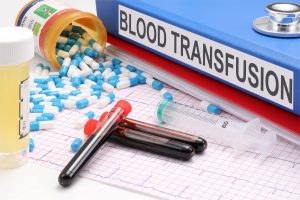You might be the carrier of a genetic disorder and not even know it; that was me up until a few years ago.
My family doctor noticed something odd in my bloodwork: my mean corpuscular volume (the volume of my red blood cells) was abnormally low, despite my blood ferritin levels (iron stores) being normal.
After a genetic screen, it turns out I have thalassemia.
Thalassemia is a category of blood disorders related to abnormal hemoglobin production. Since hemoglobin is made out of two alpha and two beta chains (four in total), the specific thalassemia that one might have is related to which coding allele is affected.
If the allele coding for the alpha-globin chain is affected, then the resulting genetic disorder is alpha thalassemia. Ditto for the beta-globin chain (beta-thalassemia).
Lucky for me, I have beta thalassemia minor or thalassemia trait, meaning only one of my beta-globin alleles (the gene that codes for hemoglobin) is defective. This means that only one of the four hemoglobin subunits in my blood is dysfunctional, leaving three other functional hemoglobins to pick up the slack.
This is the reason why I have no symptoms, and also why I didn’t find out that I have a genetic disorder until my mid-20s.
About 1.5 per cent of the global population (about 80-90 million people) are beta-thalassemia carriers. This number jumps up in the Middle East (where my family is from), as upwards of 10 per cent of the population are carriers, according to some estimates.
If you’re unlucky enough to inherit two faulty beta-globin genes, you can have beta thalassemia intermedia (mild to moderate anemia) or beta thalassemia major (severe anemia, requiring lifelong blood transfusions).
About 60,000 people are born annually with symptomatic forms of thalassemia. Many countries with higher thalassemia carrier populations have prevention programs in place to reduce these numbers, which typically involve genetic screening.
Treatment options: From traditional to cutting-edge
For those with symptomatic forms of thalassemia, particularly transfusion-dependent thalassemia (TDT), a range of treatment options are available:
- Blood transfusions:
For sufferers of severe thalassemia, regular blood transfusions are necessary. This replenishes the blood of these patients with functional red blood cells and allows them to live relatively normal lives. The challenge here is that multiple transfusions can risk iron overload, which puts organs at risk via increased oxidative stress. Iron chelation therapy can combat this, where certain kinds of small molecules (deferasirox, deferiprone, or deferoxamine) bind to excess iron, preventing them from accumulating in organs and instead leaving the body through the usual excretion routes (urine and feces).
- Folic acid supplementation:
Milder forms of thalassemia can be treated with a simple folic acid supplementation, as this small molecule supports red blood cell production.
- Hydroxyurea and/or thalidomide
Both hydroxyurea and thalidomide (yes, that thalidomide), either individually or in combination, have been shown in clinical studies to boost hemoglobin levels in patients suffering from beta-thalassemia but who don’t respond well to blood transfusions.
- Splenectomy
One potential treatment method for TDT is removing the spleen, a blood-filtering non-vital organ. Though some studies have shown promise for this treatment, there is an increased risk of certain cardiovascular events as well as infection risks related to the spleen removal surgery itself.
- Bone marrow transplantation
If you have TDT but are lucky enough to have a compatible donor, usually a sibling, a bone marrow transplant can potentially cure thalassemias.
- Gene therapy
This is a recent development for treating TDT, and there are two approved options here: Zynteglo from bluebird bio, or Casgevy (exa-cel) from Vertex Pharmaceuticals and CRISPR Therapeutics. (Casgevy has also been approved for the treatment of sickle cell disease).
Each takes slightly different approaches, but both gene therapy treatments involve the following:
a) taking hematopoietic stem cells from the patient’s blood;
b) adding in the correct hemoglobin gene to the stem cells (with Zynteglo, a lentiviral vector is used for delivering the correct gene, while Casgevy relies on CRISPR/Cas9 gene editing to modify the genome);
c) myeloablative conditioning to remove bone marrow cells; and,
d) transplanting the modified hematopoietic stem cells back into the patient.
As with all gene therapies developed and approved up to now, the biggest challenges to overcome are related to cost and accessibility. Both Zynteglo and Casgevy have eye-popping price tags (between $2-3 million per patient) and require significant manufacturing and medical infrastructures for both therapy production and administration.
In the past, certain severe forms of thalassemia were a death sentence. With the continuing advance of medical science, there are viable treatment options for many thalassemia sufferers, ranging from blood transfusions to potentially curative bone marrow transplants and gene therapies. As this area continues to develop, we can hope for even more effective and accessible therapies to combat symptomatic thalassemias.
Anis Fahandej-Sadi
Latest posts by Anis Fahandej-Sadi (see all)
- Lowering CAR T costs: Paths to more affordable cell therapies - June 5, 2025
- CGT SWOT analysis offers clues on where the industry is heading - December 5, 2024
- Thalassemia: Invisible for some, deadly for others - September 19, 2024







Comments